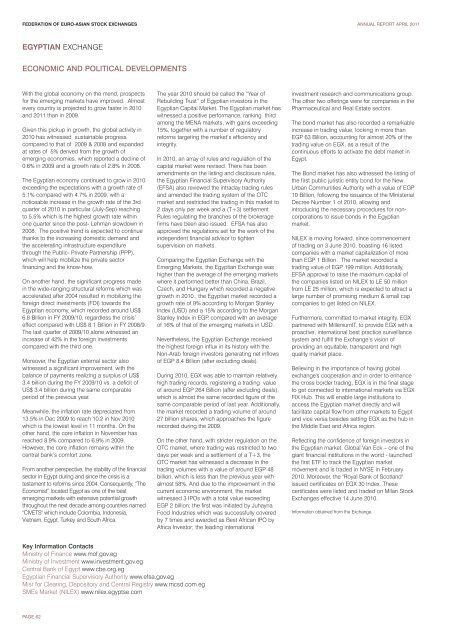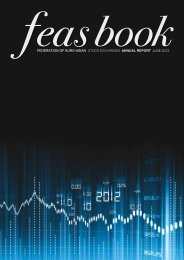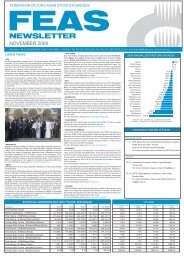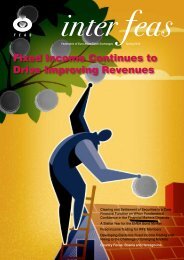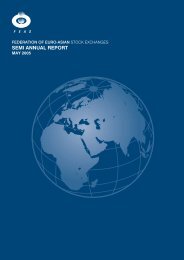Download - FEAS
Download - FEAS
Download - FEAS
You also want an ePaper? Increase the reach of your titles
YUMPU automatically turns print PDFs into web optimized ePapers that Google loves.
FEDERATION OF EURO-ASIAN STOCK EXCHANGES ANNUAL REPORT APRIL 2011<br />
EGYPTIAN EXCHANGE<br />
ECONOMIC AND POLITICAL DEVELOPMENTS<br />
With the global economy on the mend, prospects<br />
for the emerging markets have improved. Almost<br />
every country is projected to grow faster in 2010<br />
and 2011 than in 2009.<br />
Given this pickup in growth, the global activity in<br />
2010 has witnessed sustainable progress<br />
compared to that of 2009 & 2008 and expanded<br />
at rates of 5% derived from the growth of<br />
emerging economies, which reported a decline of<br />
0.6% in 2009 and a growth rate of 2.8% in 2008.<br />
The Egyptian economy continued to grow in 2010<br />
exceeding the expectations with a growth rate of<br />
5.1% compared with 4.7% in 2009, with a<br />
noticeable increase in the growth rate of the 3rd<br />
quarter of 2010 in particular (July-Sep) reaching<br />
to 5.5% which is the highest growth rate within<br />
one quarter since the post- Lehman slowdown in<br />
2008. The positive trend is expected to continue<br />
thanks to the increasing domestic demand and<br />
the accelerating infrastructure expenditure<br />
through the Public- Private Partnership (PPP),<br />
which will help mobilize the private sector<br />
financing and the know-how.<br />
On another hand, the significant progress made<br />
in the wide-ranging structural reforms which was<br />
accelerated after 2004 resulted in mobilizing the<br />
foreign direct investments (FDI) towards the<br />
Egyptian economy, which recorded around US$<br />
6.8 Billion in FY 2009/10, regardless the crisis’<br />
effect compared with US$ 8.1 Billion in FY 2008/9.<br />
The last quarter of 2009/10 alone witnessed an<br />
increase of 42% in the foreign investments<br />
compared with the third one.<br />
Moreover, the Egyptian external sector also<br />
witnessed a significant improvement, with the<br />
balance of payments realizing a surplus of US$<br />
3.4 billion during the FY 2009/10 vs. a deficit of<br />
US$ 3.4 billion during the same comparable<br />
period of the previous year.<br />
Meanwhile, the inflation rate depreciated from<br />
13.5% in Dec 2009 to reach 10.2 in Nov 2010<br />
which is the lowest level in 11 months. On the<br />
other hand, the core inflation in November has<br />
reached 8.9% compared to 6.9% in 2009.<br />
However, the core inflation remains within the<br />
central bank’s comfort zone.<br />
From another perspective, the stability of the financial<br />
sector in Egypt during and since the crisis is a<br />
testament to reforms since 2004. Consequently, “The<br />
Economist” located Egypt as one of the best<br />
emerging markets with extensive potential growth<br />
throughout the next decade among countries named<br />
"CIVETS" which include Colombia, Indonesia,<br />
Vietnam, Egypt, Turkey and South Africa.<br />
The year 2010 should be called the “Year of<br />
Rebuilding Trust” of Egyptian investors in the<br />
Egyptian Capital Market. The Egyptian market has<br />
witnessed a positive performance, ranking third<br />
among the MENA markets, with gains exceeding<br />
15%, together with a number of regulatory<br />
reforms targeting the market’s efficiency and<br />
integrity.<br />
In 2010, an array of rules and regulation of the<br />
capital market were revised. There has been<br />
amendments on the listing and disclosure rules,<br />
the Egyptian Financial Supervisory Authority<br />
(EFSA) also reviewed the intraday trading rules<br />
and amended the trading system of the OTC<br />
market and restricted the trading in this market to<br />
2 days only per week and a (T+3) settlement.<br />
Rules regulating the branches of the brokerage<br />
firms have been also issued. EFSA has also<br />
approved the regulations set for the work of the<br />
independent financial advisor to tighten<br />
supervision on markets.<br />
Comparing the Egyptian Exchange with the<br />
Emerging Markets, the Egyptian Exchange was<br />
higher than the average of the emerging markets<br />
where it performed better than China, Brazil,<br />
Czech, and Hungary which recorded a negative<br />
growth in 2010., the Egyptian market recorded a<br />
growth rate of 9% according to Morgan Stanley<br />
Index (USD) and a 15% according to the Morgan<br />
Stanley Index in EGP, compared with an average<br />
of 16% of that of the emerging markets in USD.<br />
Nevertheless, the Egyptian Exchange received<br />
the highest foreign influx in its history with the<br />
Non-Arab foreign investors generating net inflows<br />
of EGP 8.4 Billion (after excluding deals).<br />
During 2010, EGX was able to maintain relatively<br />
high trading records, registering a trading value<br />
of around EGP 264 Billion (after excluding deals),<br />
which is almost the same recorded figure of the<br />
same comparable period of last year. Additionally,<br />
the market recorded a trading volume of around<br />
27 billion shares, which approaches the figure<br />
recorded during the 2009.<br />
On the other hand, with stricter regulation on the<br />
OTC market, where trading was restricted to two<br />
days per week and a settlement of a T+3, the<br />
OTC market has witnessed a decrease in the<br />
trading volumes with a value of around EGP 48<br />
billion, which is less than the previous year with<br />
almost 58%. And due to the improvement in the<br />
current economic environment, the market<br />
witnessed 3 IPOs with a total value exceeding<br />
EGP 2 billion; the first was initiated by Juhayna<br />
Food Industries which was successfully covered<br />
by 7 times and awarded as Best African IPO by<br />
Africa Investor; the leading international<br />
investment research and communications group.<br />
The other two offerings were for companies in the<br />
Pharmaceutical and Real Estate sectors.<br />
The bond market has also recorded a remarkable<br />
increase in trading value, locking in more than<br />
EGP 63 Billion, accounting for almost 20% of the<br />
trading value on EGX, as a result of the<br />
continuous efforts to activate the debt market in<br />
Egypt.<br />
The Bond market has also witnessed the listing of<br />
the first public juristic entity bond for the New<br />
Urban Communities Authority with a value of EGP<br />
10 Billion, following the issuance of the Ministerial<br />
Decree Number 1 of 2010, allowing and<br />
introducing the necessary procedures for noncorporations<br />
to issue bonds in the Egyptian<br />
market.<br />
NILEX is moving forward, since commencement<br />
of trading on 3 June 2010, boasting 16 listed<br />
companies with a market capitalization of more<br />
than EGP 1 Billion. The market recorded a<br />
trading value of EGP 199 million. Additionally,<br />
EFSA approval to raise the maximum capital of<br />
the companies listed on NILEX to LE 50 million<br />
from LE 25 million, which is expected to attract a<br />
large number of promising medium & small cap<br />
companies to get listed on NILEX.<br />
Furthermore, committed to market integrity, EGX<br />
partnered with MilleniumIT, to provide EGX with a<br />
proactive, international best practice surveillance<br />
system and fulfill the Exchange’s vision of<br />
providing an equitable, transparent and high<br />
quality market place.<br />
Believing in the importance of having global<br />
exchange's cooperation and in order to enhance<br />
the cross border trading, EGX is in the final stage<br />
to get connected to international markets via EGX<br />
FIX Hub. This will enable large institutions to<br />
access the Egyptian market directly and will<br />
facilitate capital flow from other markets to Egypt<br />
and vice versa besides setting EGX as the hub in<br />
the Middle East and Africa region.<br />
Reflecting the confidence of foreign investors in<br />
the Egyptian market, Global Van Eck – one of the<br />
giant financial institutions in the world - launched<br />
the first ETF to track the Egyptian market<br />
movement and is traded in NYSE in February<br />
2010. Moreover, the "Royal Bank of Scotland"<br />
issued certificates on EGX 30 Index. These<br />
certificates were listed and traded on Milan Stock<br />
Exchanges effective 14 June 2010.<br />
Information obtained from the Exchange.<br />
Key Information Contacts<br />
Ministry of Finance www.mof.gov.eg<br />
Ministry of Investment www.investment.gov.eg<br />
Central Bank of Egypt www.cbe.org.eg<br />
Egyptian Financial Supervisory Authority www.efsa.gov.eg<br />
Misr for Clearing, Depository and Central Registry www.mcsd.com.eg<br />
SMEs Market (NILEX) www.nilex.egyptse.com<br />
PAGE 62


